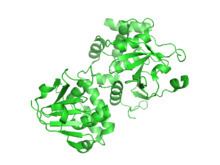EC number 2.7.7.48 ExPASy NiceZyme view | CAS number 9026-28-2 | |
 | ||
RNA-dependent RNA polymerase (RdRP), (RDR), or RNA replicase, is an enzyme that catalyzes the replication of RNA from an RNA template. This is in contrast to a typical DNA-dependent RNA polymerase, which catalyzes the transcription of RNA from a DNA template.
Contents
RNA-dependent RNA polymerase (RdRp) is an essential protein encoded in the genomes of all RNA-containing viruses with no DNA stage i.e. only RNA viruses. It catalyses synthesis of the RNA strand complementary to a given RNA template. The RNA replication process is a two-step mechanism. First, the initiation step of RNA synthesis begins at or near the 3' end of the RNA template by means of a primer-independent (de novo), or a primer-dependent mechanism that utilizes a viral protein genome-linked (VPg) primer. The de novo initiation consists in the addition of a nucleoside triphosphate (NTP) to the 3'-OH of the first initiating NTP. During the following so-called elongation phase, this nucleotidyl transfer reaction is repeated with subsequent NTPs to generate the complementary RNA product.
Poliiovirus rna dependent rna polymerase
History
Viral RdRPs were discovered in the early 1960s from studies on mengovirus and polio virus when it was observed that these viruses were not sensitive to actinomycin D, a drug that inhibits cellular DNA-directed RNA synthesis. This lack of sensitivity suggested that there is a virus-specific enzyme that could copy RNA from an RNA template and not from a DNA template.
The most famous example of RdRP is that of the polio virus. The viral genome is composed of RNA, which enters the cell through receptor-mediated endocytosis. From there, the RNA is able to act as a template for complementary RNA synthesis, immediately. The complementary strand is then, itself, able to act as a template for the production of new viral genomes that are further packaged and released from the cell ready to infect more host cells. The advantage of this method of replication is that there is no DNA stage; replication is quick and easy. The disadvantage is that there is no 'back-up' DNA copy.
Many RdRPs are associated tightly with membranes and are, therefore, difficult to study. The best-known RdRPs are polioviral 3Dpol, vesicular stomatitis virus L, and hepatitis C virus NS5B protein.
Many eukaryotes also have RdRPs involved in RNA interference; these amplify microRNAs and small temporal RNAs and produce double-stranded RNA using small interfering RNAs as primers. In fact these same RdRPs that are used in the defense mechanisms can be usurped by RNA viruses for their benefit.
RdRps are highly conserved throughout viruses and is even related to telomerase, though the reason for such high conservation in such diverse organisms is an ongoing question as of 2009. The similarity has led to speculation that viral RdRps are ancestral to human telomerase.
Structure
All the RNA-directed RNA polymerases, and many DNA-directed polymerases, employ a fold whose organization has been likened to the shape of a right hand with three subdomains termed fingers, palm, and thumb. Only the palm subdomain, composed of a four-stranded antiparallel beta-sheet with two alpha-helices, is well conserved among all of these enzymes. In RdRp, the palm subdomain comprises three well-conserved motifs (A, B, and C). Motif A (D-x(4,5)-D) and motif C (GDD) are spatially juxtaposed; the Asp residues of these motifs are implied in the binding of Mg2+ and/or Mn2+. The Asn residue of motif B is involved in selection of ribonucleoside triphosphates over dNTPs and, thus, determines whether RNA rather than DNA is synthesized. The domain organization and the 3D structure of the catalytic centre of a wide range of RdPps, even those with a low overall sequence homology, are conserved. The catalytic centre is formed by several motifs containing a number of conserved amino acid residues.
Classification
There are 4 superfamilies of viruses that cover all RNA-containing viruses with no DNA stage:
The RNA-directed RNA polymerases in the first of the above superfamilies can be divided into the following three subgroups:
Flaviviruses produce a polyprotein from the ssRNA genome. The polyprotein is cleaved to a number of products, one of which is NS5. Recombinant dengue type 1 virus NS5 protein expressed in Escherichia coli exhibits RNA-dependent RNA polymerase activity. This RNA-directed RNA polymerase possesses a number of short regions and motifs homologous to other RNA-directed RNA polymerases.
